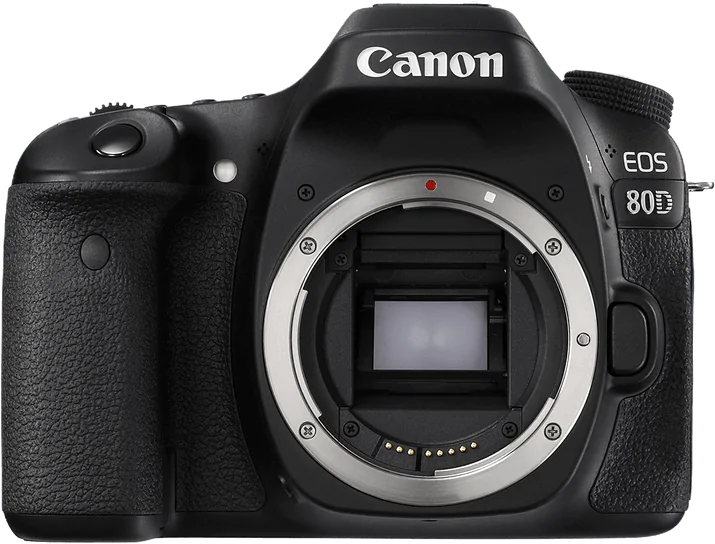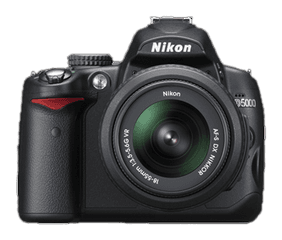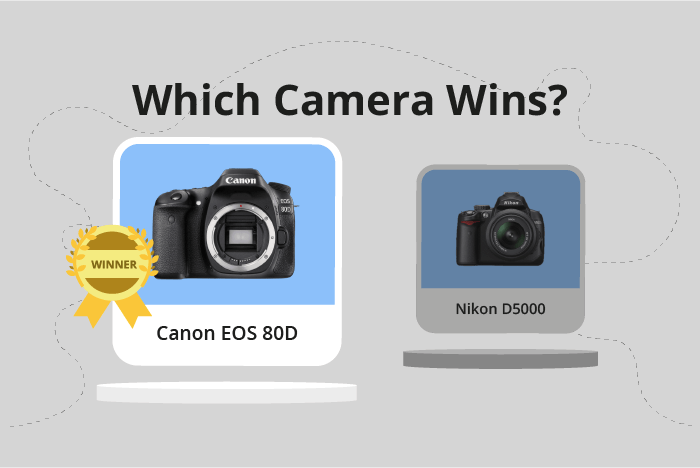Canon EOS 80D vs Nikon D5000 Comparison
Canon EOS 80D

Nikon D5000

The Canon EOS 80D outperforms the Nikon D5000 with a score of 64/100 compared to 41/100. Both cameras are DSLRs, released in 2016 and 2009 respectively. They share similar dimensions, with the Canon EOS 80D at 139 x 105 x 79mm and the Nikon D5000 at 127 x 104 x 80mm. However, the Canon EOS 80D weighs more at 730g compared to the Nikon D5000’s 590g.
The Canon EOS 80D’s higher score signifies its superior performance and features. Its launch price of $1200 reflects the quality and advanced technology. On the other hand, the Nikon D5000, with a launch price of $730, offers a more budget-friendly option while still providing decent performance.
Considering the scores and specifications, the Canon EOS 80D is the better choice for those seeking higher quality and performance, while the Nikon D5000 caters to those looking for a more affordable option.
Canon EOS 80D vs Nikon D5000 Overview and Optics
The Canon EOS 80D outperforms the Nikon D5000 in optics with a score of 63/100 compared to the Nikon’s 45/100. Both cameras share some common specifications, including the CMOS sensor type, APS-C sensor size, and the lack of image stabilization. However, the Canon EOS 80D has several advantages over the Nikon D5000.
The Canon EOS 80D boasts a higher megapixel count at 24.2 compared to the Nikon D5000’s 12.3. This results in sharper images with more detail. Additionally, the Canon EOS 80D features a faster shooting speed of 7 frames per second, allowing for better action and sports photography. The Canon EOS 80D also has a more advanced processor, the Digic 6, which contributes to better image quality and faster processing times. The DXOMARK score for the Canon EOS 80D sensor is 79, which is superior to the Nikon D5000’s score of 72, indicating that the Canon camera has better overall image quality.
The Nikon D5000, however, is not without its merits. It has a compatible lens mount, the Nikon F DX, which allows for a wide range of lens options for photographers. This compatibility provides flexibility for various shooting situations and styles.
Considering these factors, the Canon EOS 80D emerges as the better camera in terms of optics due to its higher megapixel count, faster shooting speed, and better sensor quality. While the Nikon D5000 has a compatible lens mount, it falls short in other areas, making the Canon EOS 80D the clear winner in this comparison.
Canon EOS 80D vs Nikon D5000 Video Performance
The Canon EOS 80D emerges as the winner in the video capabilities comparison, scoring 70 out of 100, while the Nikon D5000 scores 49. Both cameras share some common video specifications, including built-in time-lapse functionality. However, there are notable differences between the two cameras, which contribute to the Canon EOS 80D’s superior performance in video recording.
The Canon EOS 80D excels with its higher maximum video resolution and frame rate. It offers Full HD video recording at a resolution of 1920 x 1080 pixels, which results in sharper and more detailed footage. Furthermore, the camera supports a maximum video frame rate of 60fps, allowing for smoother motion capture and the option to create slow-motion effects in post-production. These features make the Canon EOS 80D a more versatile and capable camera for video enthusiasts.
On the other hand, the Nikon D5000’s video capabilities are limited by its lower maximum video resolution and frame rate. It records Standard HD video at a resolution of 1280 x 720 pixels, which is less detailed than Full HD. Additionally, the camera’s maximum video frame rate is only 24fps, which may result in less smooth motion and fewer creative options in post-production.
Taking into account these differences in video specifications, the Canon EOS 80D is the superior choice for those prioritizing video performance. Its higher video resolution and frame rate provide users with more detailed footage and greater creative flexibility. While the Nikon D5000 still offers time-lapse functionality, its lower resolution and frame rate make it less suitable for users seeking top-notch video capabilities.
Canon EOS 80D vs Nikon D5000 Features and Benefits
The Canon EOS 80D emerges as the winner in the features comparison, scoring 70/100, while the Nikon D5000 lags behind with a score of 34/100. Both cameras share some specifications, such as screen size and the lack of GPS functionality. However, the EOS 80D outperforms the D5000 in various aspects, which contribute to its higher score.
The EOS 80D has a larger screen size of 3 inches compared to the D5000’s 2.7 inches. Moreover, the screen resolution of the EOS 80D is significantly higher, with 1,040,000 dots, while the D5000 has only 230,000 dots. This difference means the EOS 80D provides a clearer and sharper display for better image preview and easier menu navigation. Additionally, the EOS 80D features a touchscreen, which allows for more intuitive control, and a flip screen, making it convenient for capturing images and videos from different angles.
In terms of connectivity, the EOS 80D also surpasses the D5000 with its built-in Wi-Fi, enabling easy sharing and remote control of the camera. The D5000, on the other hand, lacks both Wi-Fi and Bluetooth capabilities.
Despite its lower score, the Nikon D5000 still has its merits. Its smaller screen size and the absence of advanced connectivity options may result in a more straightforward user experience for those who prefer simplicity.
Taking these points into account, the Canon EOS 80D proves to be the superior camera in terms of features, offering a larger and higher-resolution touchscreen, a flip screen, and Wi-Fi connectivity. The Nikon D5000, while not as feature-rich, may appeal to those seeking a more basic and user-friendly option.
Canon EOS 80D vs Nikon D5000 Storage and Battery
The Canon EOS 80D outperforms the Nikon D5000 in storage and battery, with a score of 43/100 compared to the Nikon’s 27/100. Both cameras have a single memory card slot and do not support USB charging. They accept SD and SDHC memory cards, but the Canon EOS 80D also accepts SDXC cards and is UHS-I compatible.
The Canon EOS 80D excels in battery life, offering 960 shots per charge with its LP-E6N battery, while the Nikon D5000 only provides 510 shots with its EN-EL9a battery. This significant difference in battery life makes the Canon EOS 80D a better choice for extended shooting sessions.
However, the Nikon D5000 has no significant advantage in storage and battery over the Canon EOS 80D. Considering the scores and specifications, the Canon EOS 80D is the superior choice in terms of storage and battery performance.
Canon EOS 80D vs Nikon D5000 – Our Verdict
Are you still undecided about which camera is right for you? Have a look at these popular comparisons that feature the Canon EOS 80D or the Nikon D5000:

